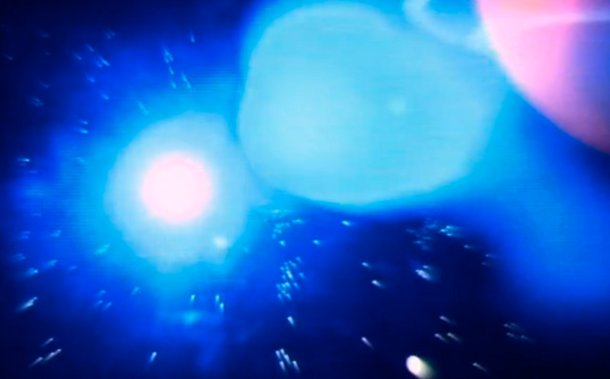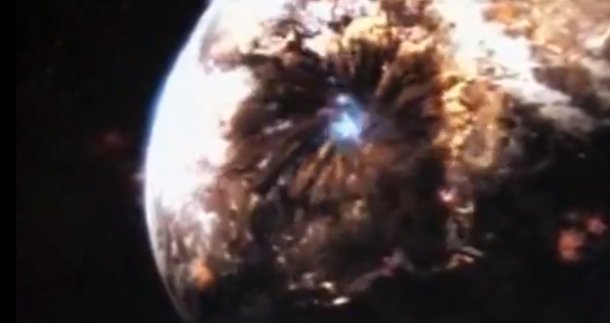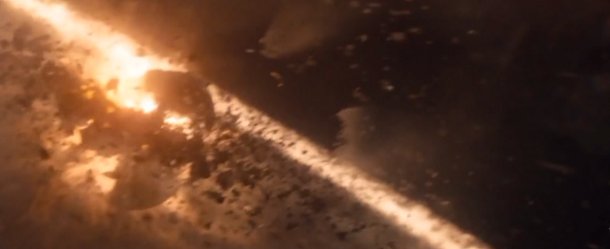Ever feel like you’re alone in the universe, that there’s no one else out there? It’s probably because alien life is too busy blowing itself up as we’ll see in this countdown of the most significant planetary destructions in SF history...

5. SKARO
INHABITANTS : Daleks, Kaleds, Thals, a Magnedon, Varga plants.
PLACES TO SEE: Not the most friendly of planets, Skaro’s notable features include a petrified jungle, the Ocean of Ooze and high levels of nuclear fallout- that’s not even including the Dalek’s metal city. Explorers keen to roam Skaro should pack anti-radiation gloves, er, drugs.
Get sneak previews, exclusive competitions and details of special events each month!
PLANET FACTS: Skaro is the twelfth planet from its sun and one of the most frequently visited places in Doctor Who . Even before Skaro was destroyed it was a dead planet, reduced to a radioactive wasteland thanks to the Thousand Year War between the Kaleds and the Thals. This conflict led to the creation of the Daleks, and you just knew they weren’t going to renovate the place.
HOW IT WAS DESTROYED: The Seventh Doctor destroyed Skaro in the 1988 story "Remembrance of the Daleks". Using a Time Lord weapon called the Hand of Omega, he causes Skaro’s sun to go supernova and wipe it out.
IMPACT: The destruction of Skaro can be seen as an opening shot in the Time War. Subsequent adventure "Asylum Of The Daleks" is set on Skaro without any reference to its demise - a point before its destruction, we can only assume - while the novel War of the Daleks claims that the Seventh Doctor blew up a decoy world.
TRIVIA: Skaro’s moon, Flidor, is mined by Daleks for its gold.

4. EARTH
INHABITANTS: The human race, mice, dolphins.
PLACES TO SEE: Coastlines, notably the award winning fjords of Norway.
PLANET FACTS: Mostly harmless.
HOW IT WAS DESTROYED: In The Hitchhikers Guide To The Galaxy Prostetnic Vogon Jeltz demolished the Earth to make room for a hyperspace bypass. We can’t really get mad, though: the plans were on display at Alpha Centauri for 50 years so we had plenty of time to file a formal objection. To make things worse, Jeltz recited some notoriously awful Vogon poetry in the aftermath.
IMPACT: The timing couldn’t have been worse. Turns out the Earth was a giant computer commissioned by two pan-dimensional beings disguised as mice and it was moments away from finishing a 10-million-year programme when it was blown up.
TRIVIA: Dolphins made a second Earth to finish the job of the first one, much to the further confusion of intergalactic traveller Arthur Dent.

3. VULCAN
INHABITANTS: Vulcans
PLACES TO SEE: Tourist attractions on Vulcan include active volcanoes and lava fields. If you can’t stand the heat you can always cool off with a tour of historical Vulcan ruins whose appearance on screen was inspired by Stonehenge.
PLANET FACTS: A moonless planet (on television at least), Vulcan has a higher gravity than Earth and a hotter climate. Fire storms are part of a Vulcan’s weather forecast, with the Enterprise’s Doctor McCoy famously realising how accurate the phrase "hot as Vulcan" really was.
HOW IT WAS DESTROYED: In 2009’s Star Trek Vulcan is swallowed up by an artificial black hole placed in the planet’s core by Romulan commander, Nero. Following the destruction of his own planet, Romulus, Nero craved revenge on the man he held responsible, Ambassador Spock.
IMPACT: The death of the planet is a body blow to Vulcan’s most famous export, Spock. Unsurprising really, seeing as he can instinctively sense when he’s near it. All this playing around with black holes also creates a parallel Star Trek universe, two versions of Spock, and allows the new films and the TV show to co-exist without fans in-fighting online. Well, not too much.
TRIVIA: As well as possessing pointy ears, the population of Vulcan are all vegetarians.

2. ALDERAAN
INHABITANTS: Sentient insects called Killiks, humans.
PLACES TO SEE: Alderaan was a beautiful world whose inhabitants worked hard to preserve its natural beauty. With sweeping mountain ranges and grasslands it was once nicknamed the ‘Shining Star.’ Now all that’s left of it are some rocky remains floating in space as an asteroid field called the Graveyard.
PLANET FACTS: The lush, mountainous world of Alderaan was a peaceful place that valued education and art. Despite a history of minor conflict it kept a safe distance from intergalactic warfare. Funny how things turn out.
HOW IT WAS DESTROYED: Possibly the most famous planet destruction in all of SF, Alderaan was incinerated by the Death Star in Star Wars . Knowing that the Rebel threat against the Empire was growing, Grand Moff Tarkin made an example of Alderaan by removing it from the star charts altogether.
IMPACT: Blasting a planet apart in a couple of seconds doesn’t go unnoticed as Obi-Wan Kenobi feels "a great disturbance in the Force." Alderaan’s destruction rallies together the Rebel cause, though, and they even the score by blowing up the Death Star.
TRIVIA: Alderaan gets a mention in the Red Hot Chili Peppers song Californication.

1. KRYPTON
INHABITANTS: Kryptonians, Xan, Teklons,
PLACES TO SEE: Krypton has such diverse scenery as the Scarlet Jungle, the Gold Volcano and the Jewel Mountains. Alternatively, take a city break and visit the capital cities Kandor and Kryptonopolis.
PLANET FACTS: In its original comic book depiction Krypton was an evolved version of Earth with an entire population of "super-men." Later stories revealed that Earth's yellow sun - as opposed to Krypton's red sun, Rao - was responsible for Kal-El's powers. Over the years Krypton has gone through a few different looks, such as an icy techno-kingdom and a retro Flash Gordon inspired metropolis.
HOW IT WAS DESTROYED: Poor Krypton. In every branch of the franchise the planet dies. Usually this is due to natural causes such as its red sun going supernova or the explosion of the world’s uranium core.
IMPACT: Superman wouldn’t be the man he is today if his home planet was still around. The destruction of Krypton is at the heart of the Superman mythos, which usually focuses on how the character was the last surviving Kryptonian. By arriving on Earth Superman could unleash his powers but the debris of his homeworld would become his Achilles heel in the devastating form of Kryptonite - soon adopted as a catch-all word to refer to a person’s weakness.
The shockwaves of Krypton’s obliteration reach deep into popular culture, giving birth to Superman and so establishing the entire superhero template. No wonder it's at number one.
TRIVIA: Out of the 15 types of Kryptonite, gold is the most dangerous. It permanently removes a Kryptonian's superpowers.
Honourable mentions: Earth’s greedy twin Mondas, Cybertron, and the Klingon moon Praxis (it’s not a planet but it’s close enough!)
Dominic Carter
SFX Magazine is the world's number one sci-fi, fantasy, and horror magazine published by Future PLC. Established in 1995, SFX Magazine prides itself on writing for its fans, welcoming geeks, collectors, and aficionados into its readership for over 25 years. Covering films, TV shows, books, comics, games, merch, and more, SFX Magazine is published every month. If you love it, chances are we do too and you'll find it in SFX.


